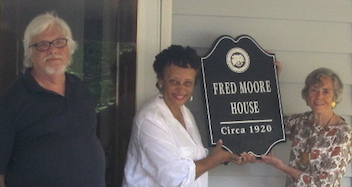Historic Homes

Get the inside scoop on the history of the Southport Historic Home Plaques
Story by Kass Fincher
If you’re planning to join in the WinterFest Tour of Homes here in Southport this month, you will get to see some beautiful historic homes from the inside, elegantly decorated to celebrate the holiday season. But these are a just small sample of the many historic homes that make our town so colorfully quaint. And most of these downtown homeowners join in the holiday spirit too, with exterior decorations that make one’s neighborhood walk even more fun.
The Tour, sponsored by the Southport Historical Society, is a much-anticipated community event and a fundraiser for educational scholarships and other activities. The Society was established in 1976 “to preserve and interpret the unique history of Southport,” according to their website. In addition to the Tour, the organization offers lectures, tours, preservation of historic properties like the Old Jail and old cemeteries, and visitor information at the Fort Johnston Visitor Center.
One other role the Society plays is identifying and installing plaques on historic homes and buildings. On its website, the organization describes the process for requesting such a designation. The homeowner does the research and makes an application to the Society. The house or building must be at least 75 years old. Copies of deeds from the courthouse in Bolivia provide the earliest information possible, including who owned the house originally. After the application is submitted, with a check for $125 to the Society, the organization will review the documents for approval.
Southport residents Martha and Bill Johnson review the documents submitted to the Society, researching records like deeds, census reports and even wills. They receive a few new applications each year, often uncovering surprising information about the original owners. “Southport is full of stories, and sometimes the stories aren’t backed up by actual facts,” Martha said. “Some names of the houses were word-of-mouth, what they were known by, not necessarily the original owners. Bill will go do his research on the house. Then the question is do you give it the name of what people have always called it, or do you give it the name of the original owner or builder?”
They try to go with the name of the original owner or builder. Martha gave another interesting example of their investigations. “The first owner of a house on East Nash was Dr. T. B. McClintic, who worked at the quarantine station,” she explained. “Bill learned that the doctor lived here as an adult in 1900 and studied yellow fever. After he left here he went to Montana and helped study Rocky Mountain Spotted Fever, where he unfortunately died of that disease.” The good doctor was also the namesake for a tugboat in Wilmington that was originally commissioned in 1932 to transport doctors to ships to treat sick seamen. The current owners of the Dr. T. B. McClintic house were excited to hear about the life of the original owner; the Johnsons enjoy doing the research and especially enjoy presenting the homeowners with not only a plaque, but also a bit of history about their house.
If your home is approved and your plaque is received, you would join over 130 homes in our town with this historic designation. In the book “The Architecture of Southport,” author Carl Lounsbury describes homes built in the late 1700s all the way up to the early 1900s. The book, available at the Fort Johnston Visitor Center, identifies and describes 151 historic structures in Southport. Lounsbury notes that the earliest-built home still standing is probably the Walker-Pyke house on Bay Street, constructed in the early 1800s.
Lounsbury notes that as Smithville (now Southport) grew in popularity as a summer resort before the Civil War, several boarding houses were built to accommodate the visitors. A still-standing example is the Bell-Clemmons house on Moore Street. After the war ended, building activity was slow. But in the late 1800s, the town’s appearance radically changed, with more than 100 houses built in the last decade of that century. Streets such as Atlantic, Brunswick and Howe were extended to provide lots for new homes.
The designs of these homes in the late 19th and early 20th century were the work of master carpenter-builders like A.J. Robbins, Henry and Joseph Daniel, and George Davis. They were the most prolific builders in Southport; they were skilled craftsmen who often repeated designs their customers liked. They often used the “double cottage” plan, a one story house with two rooms on each side of a central hallway. Dozens of homes in Southport were built in this way, notably the R. Dosher Sr. house on Lord Street, and the C.G. Smith and Foley cottages on Atlantic.
Their plans were fairly traditional. But one other builder ventured outside of the local building tradition to experiment with unconventional floor plans and irregular roof lines, somewhat reminiscent of the Victorian approach. His name was W. T. Ottaway; one of his designs is the T. St. George house on Lord Street.
Though Lounsbury says the Great Depression ended the era of the great master carpenters of Southport, we still see many examples today of beautiful design and construction of new homes that reflect the traditions of the past. We also know that many of the town’s old historic homes have been renovated and brought up to the present with interior and exterior upgrades and additions, preserving the past but affording today’s amenities.
Whether the houses are new construction or old homes revived, the residential character of downtown Southport is alive and well. So be sure to walk around this holiday season and appreciate the work of our past and present designers and builders, not to mention the homeowners’ seasonal touch, and you’ll be glad you live here.











Walking down Argyle Road from the Hesketh Park end,the housing on the left-hand side is 99% ‘new’ apartment blocks. There are victorian houses in the area and the right-hand side of Argyle has stately 1920ish houses. My question is; was there ever victorian houses on the left-hand side and if so why were they pulled down. My friend and I walk the roads for exercise and this situation puzzles us. Maybe you could provide an answer. Many Thanks Robert and Jim